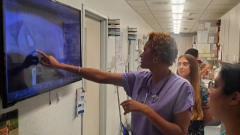
AI brings the reference lab into the clinic
Dr Richard Goldstein explores how AI in diagnostics can enhance efficiency and save time
Episodes in this series

Content sponsored by Zoetis
Adam Christman, DVM, MBA: Zoetis Diagnostics is launching things left and right. Can you tell me about the momentum behind it?
Richard Goldstein, DVM, DACVIM (SAIM), DECVIM-CA: A few years ago, Zoetis decided to get involved with diagnostics and hired a bunch of people with insight into that area—me included. Starting from scratch, we discussed what we could build to help the profession. What we’ve launched over the last couple of years is an experience. For a veterinarian or a veterinary technician, getting a diagnosis is important. It is crucial for therapy. However, it should not be difficult. You should be able to have support, opinions from other people, and easy-to-use instruments. In vet school, specialists are around left and right. They are not as accessible while practicing. We wanted to Bubble Wrap every veterinarian and technician and give them the tools they need for the tests they run.
Adam Christman, DVM, MBA: Tell us how the Vetscan Imagyst analyzer sets itself apart from others on the market.
Richard Goldstein, DVM, DACVIM (SAIM), DECVIM-CA: The goal is to bring a reference lab into the clinic so there is less of a need to send things out for an answer or call a lab. The Imagyst is an 8-pound high-resolution scanner [that] scans images of samples and slides up to the cloud. Once they are in the cloud, the images can be sent to a clinical pathologist, and they will turn around results within 2 hours. This happens 24 hours a day, all year round.
However, with emerging AI, there are a lot of straightforward results that can be done quicker and cheaper. They will never replace a clinical pathologist, but if the AI is good, there are some benefits to utilizing that technology. We do so with fecal application, [for which] results appear within 10 minutes. We also launched a dermatology application that analyzes yeast and bacteria within the ears or on the skin.
The problem in practices today is there is just not enough people to handle the workload. If technology can free up a veterinarian or technician to be able to take care of a pet and their owner, let’s do it. That way they aren’t splitting their time between looking under a microscope, figuring out the results of a test, and providing care.
Adam Christman, DVM, MBA: How can practice owners, veterinarians, and even pet owners benefit from AI?
Richard Goldstein, DVM, DACVIM (SAIM), DECVIM-CA: AI is a fabulous tool, but like anything else, it must be used responsibly. It will also never replace a human expert. Rather, the AI will be trained by the human expert. If a veterinarian provides information about skin to the AI, the AI will only know what the veterinarian knows, not beyond. Every AI application we launch is run through an extensive validation process. The results have to be as a good as if it were a specialist looking at them.
The other important component is AI has to be backed up by a human. If you are running an AI application on images and you have a question about them, something doesn’t look right, or you want to look deeper, we have an add-on expert review. With the push of a button, the images go to a clinical pathologist.
Adam Christman, DVM, MBA: Can you walk through a case of using the virtual laboratory?
Richard Goldstein, DVM, DACVIM (SAIM), DECVIM-CA: The virtual lab is here to mitigate anxiety in any situation. Think of an emergency [department] with a bunch of pets waiting to be seen and a dog vomiting in the back. We have a network of specialists for each field, and as part of our online platform, a veterinarian can schedule a consult at any time—whether it is for a scary case, something on the schedule, or just wanting an extra level of preparation. The lab will also have any tests you’ve run before, and if not, you can easily upload them for a complete profile of the situation. It is an umbrella that has point of care with a reference lab, and it acts as a more modern, efficient, and supportive way to treat the veterinarian.
Newsletter
From exam room tips to practice management insights, get trusted veterinary news delivered straight to your inbox—subscribe to dvm360.




























